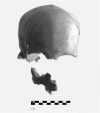Application and implications of radiocarbon dating in forensic case work: when medico-legal significance meets archaeological relevance
- PMID: 39435462
- PMCID: PMC11491528
- DOI: 10.1093/fsr/owae046
Application and implications of radiocarbon dating in forensic case work: when medico-legal significance meets archaeological relevance
Abstract
The estimation of the postmortem interval for skeletal remains is a crucial aspect of forensic anthropology. This paper illustrates the importance of radiocarbon analysis for establishing medico-legal significance and supporting forensic identification, through the analysis of three case studies for which the years of both birth and death were investigated. In Audresselles, Northern France, a partial skull was discovered with no contextual information or identity. Radiocarbon dating yielded an average calibrated calendar age of 4232 BCE (92.5% probability), indicating significant archaeological value but no forensic relevance. In the second case, skeletal remains were found in the flooded underground of a historical fort at Wimereux, Northern France, also with no identity. Radiocarbon dating based on the bomb-pulse curve indicated a calibrated date of death in 1962 CE (37.3% probability) or 1974-1975 CE (58.1% probability), both surpassing the French statute of limitations. Lastly, a skeleton with a suspected identity was discovered near Valenciennes, Northern France, and various biological tissues underwent radiocarbon dating. A bone sample suggested a calibrated date of death of 1998-2002 CE (84.6% probability), differing from a hair sample (2013-2018 CE, 83.3% probability) because of the slower bone tissue remodeling process. DNA analysis confirmed the person's identity, reported missing a decade prior to the discovery of the remains, following the alignment of the radiocarbon results with the individual's year of birth based on dental tissues and year of death. These case studies reveal that traditional radiocarbon dating and bomb-pulse dating are essential tools for estimating the postmortem interval, providing mutual benefits for archaeologists, forensic anthropologists, and the criminal justice system.
Key points: Traditional radiocarbon dating and bomb-pulse dating are essential tools to establish the archaeological relevance or medico-legal significance of human skeletal remains.Bomb-pulse dating enables assessment of an individual's years of birth and death.Bomb-pulse dating helps to narrow down the pool of candidates for identification.Radiocarbon analysis provides mutual benefits for archaeologists, forensic anthropologists, and the criminal justice system.
Keywords: 14C; bomb-pulse dating; forensic anthropology; identification; postmortem interval.
© The Author(s) 2024. Published by OUP on behalf of the Academy of Forensic Science.
Figures






Similar articles
-
A Review of Bomb Pulse Dating and its Use in the Investigation of Unidentified Human Remains.J Forensic Sci. 2020 May;65(3):676-685. doi: 10.1111/1556-4029.14227. Epub 2019 Nov 5. J Forensic Sci. 2020. PMID: 31688960 Review.
-
Suspect graveyard burial (South Armagh, N. Ireland): Combined search, forensic anthropology and radiocarbon dating.Sci Justice. 2023 Jan;63(1):1-8. doi: 10.1016/j.scijus.2022.10.002. Epub 2022 Oct 22. Sci Justice. 2023. PMID: 36631174
-
Personal identification of cold case remains through combined contribution from anthropological, mtDNA, and bomb-pulse dating analyses.J Forensic Sci. 2012 Sep;57(5):1354-60. doi: 10.1111/j.1556-4029.2012.02223.x. Epub 2012 Jul 16. J Forensic Sci. 2012. PMID: 22804335 Free PMC article.
-
Identification of a decedent in a 103-year-old homicide case using forensic anthropology and genetic genealogy.Forensic Sci Res. 2022 Mar 11;7(3):412-426. doi: 10.1080/20961790.2022.2034717. eCollection 2022. Forensic Sci Res. 2022. PMID: 36353312 Free PMC article.
-
The impact of age at death on the lag time of radiocarbon values in human bone.Forensic Sci Int. 2015 Jun;251:56-60. doi: 10.1016/j.forsciint.2015.03.024. Epub 2015 Apr 2. Forensic Sci Int. 2015. PMID: 25863698 Review.
Cited by
-
Forensic identification in a multidisciplinary perspective focusing on big challenges.Forensic Sci Res. 2024 Sep 30;9(3):owae063. doi: 10.1093/fsr/owae063. eCollection 2024 Sep. Forensic Sci Res. 2024. PMID: 39435461 Free PMC article. No abstract available.
References
-
- Saukko P, Knight B. Knight’s: forensic pathology. 4th ed. London (UK): CRC Press; 2015.
-
- Rognum TO, Holmen S, Musse MA, et al. . Estimation of time since death by vitreous humor hypoxanthine, potassium, and ambient temperature. Forensic Sci Int. 2016;262:160–165. - PubMed
-
- Englisch CN, Alrefai R, Lesan CM, et al. . Postmortem sympathomimetic iris excitability. Ann Anat. 2024;254:152240. - PubMed
LinkOut - more resources
Full Text Sources

